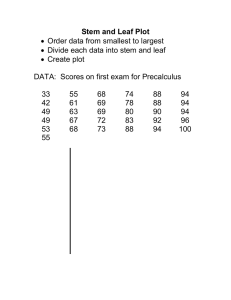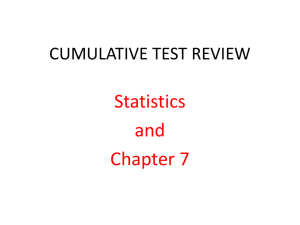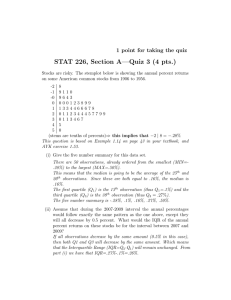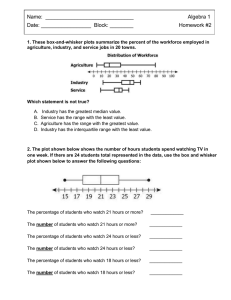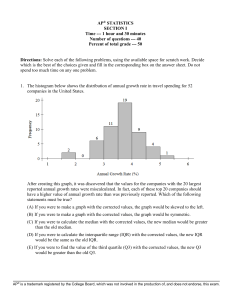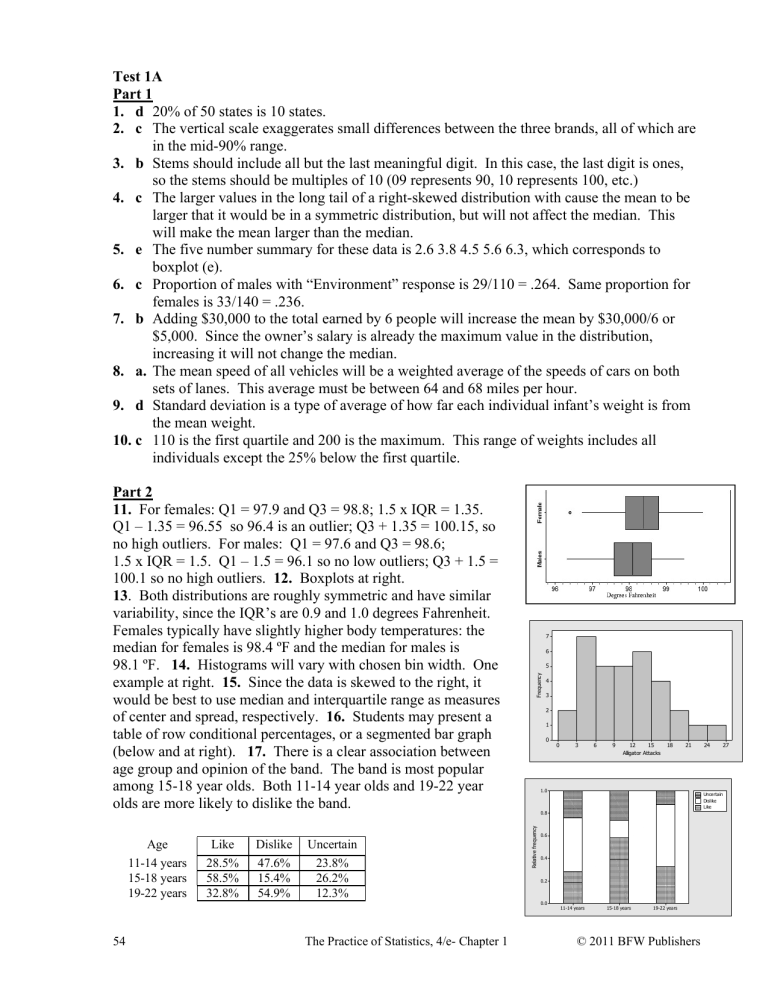
Test 1A Part 1 1. d 20% of 50 states is 10 states. 2. c The vertical scale exaggerates small differences between the three brands, all of which are in the mid-90% range. 3. b Stems should include all but the last meaningful digit. In this case, the last digit is ones, so the stems should be multiples of 10 (09 represents 90, 10 represents 100, etc.) 4. c The larger values in the long tail of a right-skewed distribution with cause the mean to be larger that it would be in a symmetric distribution, but will not affect the median. This will make the mean larger than the median. 5. e The five number summary for these data is 2.6 3.8 4.5 5.6 6.3, which corresponds to boxplot (e). 6. c Proportion of males with Environment response is 29/110 = .264. Same proportion for females is 33/140 = .236. 7. b Adding $30,000 to the total earned by 6 people will increase the mean by $30,000/6 or $5,000. Since the owners salary is already the maximum value in the distribution, increasing it will not change the median. 8. a. The mean speed of all vehicles will be a weighted average of the speeds of cars on both sets of lanes. This average must be between 64 and 68 miles per hour. 9. d Standard deviation is a type of average of how far each individual infants weight is from the mean weight. 10. c 110 is the first quartile and 200 is the maximum. This range of weights includes all individuals except the 25% below the first quartile. Age 11-14 years 15-18 years 19-22 years Like 28.5% 58.5% 32.8% Dislike 47.6% 15.4% 54.9% Uncertain 23.8% 26.2% 12.3% 7 6 Frequency 5 4 3 2 1 0 The Practice of Statistics, 4/e- Chapter 1 3 6 9 12 15 Alligator Attacks 18 21 24 27 Uncertain Dislike Like 0.8 0.6 0.4 0.2 0.0 54 0 1.0 Relative frequency Part 2 11. For females: Q1 = 97.9 and Q3 = 98.8; 1.5 x IQR = 1.35. Q1 1.35 = 96.55 so 96.4 is an outlier; Q3 + 1.35 = 100.15, so no high outliers. For males: Q1 = 97.6 and Q3 = 98.6; 1.5 x IQR = 1.5. Q1 1.5 = 96.1 so no low outliers; Q3 + 1.5 = 100.1 so no high outliers. 12. Boxplots at right. 13. Both distributions are roughly symmetric and have similar variability, since the IQRs are 0.9 and 1.0 degrees Fahrenheit. Females typically have slightly higher body temperatures: the median for females is 98.4 ºF and the median for males is 98.1 ºF. 14. Histograms will vary with chosen bin width. One example at right. 15. Since the data is skewed to the right, it would be best to use median and interquartile range as measures of center and spread, respectively. 16. Students may present a table of row conditional percentages, or a segmented bar graph (below and at right). 17. There is a clear association between age group and opinion of the band. The band is most popular among 15-18 year olds. Both 11-14 year olds and 19-22 year olds are more likely to dislike the band. 11-14 years 15-18 years 19-22 years © 2011 BFW Publishers



